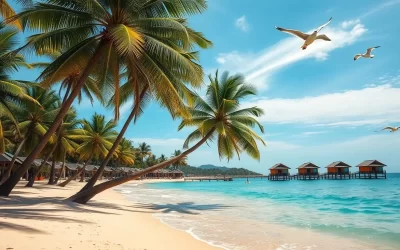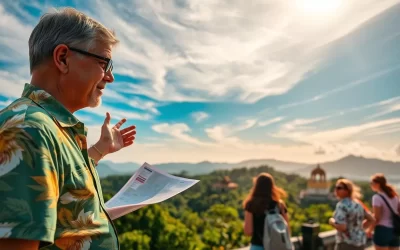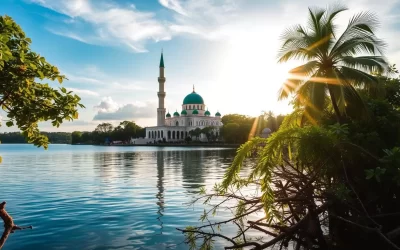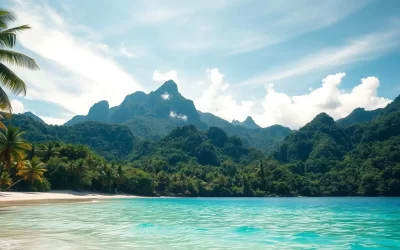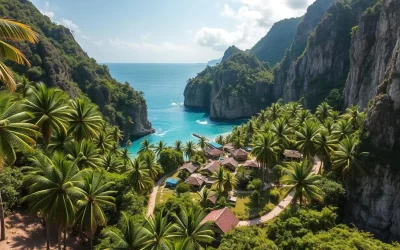Are you ready to explore one of Borneo’s most rewarding wildlife and historical destinations? Sandakan is a coastal city that offers a unique blend of nature, history, and culture. As the second-largest city in Sabah, after Kota Kinabalu, Sandakan is a must-visit destination for nature lovers and history buffs alike.
Imagine getting up close with orangutans at the Sepilok Orangutan Rehabilitation Center, cruising along the Kinabatangan River to spot wildlife in action, or visiting Turtle Island to be part of a sea turtle conservation project. These experiences await you on a trip to Sandakan, making it an unforgettable adventure.
Discover the incredible diversity of attractions, from orangutan rehabilitation centers to historical war memorials, and learn why Sandakan is often called the gateway to some of Borneo’s most precious natural treasures.
Discovering Sandakan: Malaysia’s Wildlife and Historical Gem
As you step into Sandakan, you’re not just entering a city; you’re stepping into a world where the past and present converge. Sandakan, a city on the northeastern coast of Sabah, Malaysia, is a treasure trove of historical landmarks, cultural diversity, and wildlife conservation efforts.

A Brief History of Sandakan
Sandakan was ‘officially’ founded on June 21, 1897, by William B. Pryer, a British accountant turned adventurer. However, the first European settlement, named Kampung Jerman, was established in 1872 by Scotsman William Clarke Cowie. After Kampung Jerman was destroyed by fire in 1879, Pryer rebuilt it in a new location and named it Elopura, meaning ‘The Beautiful City.’ Later, the locals renamed it Sandakan, which translates to ‘the place that was pawned’ in Sulu.
The city’s history is a fascinating tale of colonial influence, immigration, and strategic importance. Sandakan was also known as ‘Little Hong Kong’ due to the influx of immigrants from Hong Kong, contributing to its cultural diversity.
Key historical events include:
- The founding of Sandakan in 1897 by William B. Pryer
- The establishment of the first European settlement, Kampung Jerman, in 1872
- The renaming of Elopura to Sandakan, reflecting its complex history
Why Sandakan Should Be on Your Malaysia Itinerary
Sandakan is a must-visit destination for wildlife enthusiasts and history buffs. The city is home to several conservation centers, including the famous Sepilok Orangutan Rehabilitation Centre, a really good example of Malaysia’s commitment to wildlife conservation. Visitors can witness the rehabilitation process and get up close with orangutans in a natural setting.
Besides its wildlife attractions, Sandakan’s historical landmarks, such as the Agnes Keith House and the Sandakan Memorial Park, offer a glimpse into the city’s past, making it an enriching experience for travelers.
The cultural diversity of Sabah, with over 42 ethnic groups represented, adds to the city’s charm, offering a unique blend of traditions and experiences.
How to Get to Sandakan
Reaching Sandakan is relatively straightforward, with several flight options available from major Malaysian cities like Kota Kinabalu and Kuala Lumpur. The closest airport is the Sandakan Airport, which is well-connected to these cities.
For those planning to visit the Sepilok Orangutan Rehabilitation Centre or other wildlife sanctuaries, it’s essential to plan your trip around the feeding times and conservation center schedules to make the most of your visit.
By understanding the city’s history, appreciating its wildlife conservation efforts, and knowing how to get there, you’re well on your way to experiencing all that Sandakan has to offer.
Sepilok Orangutan Rehabilitation Centre
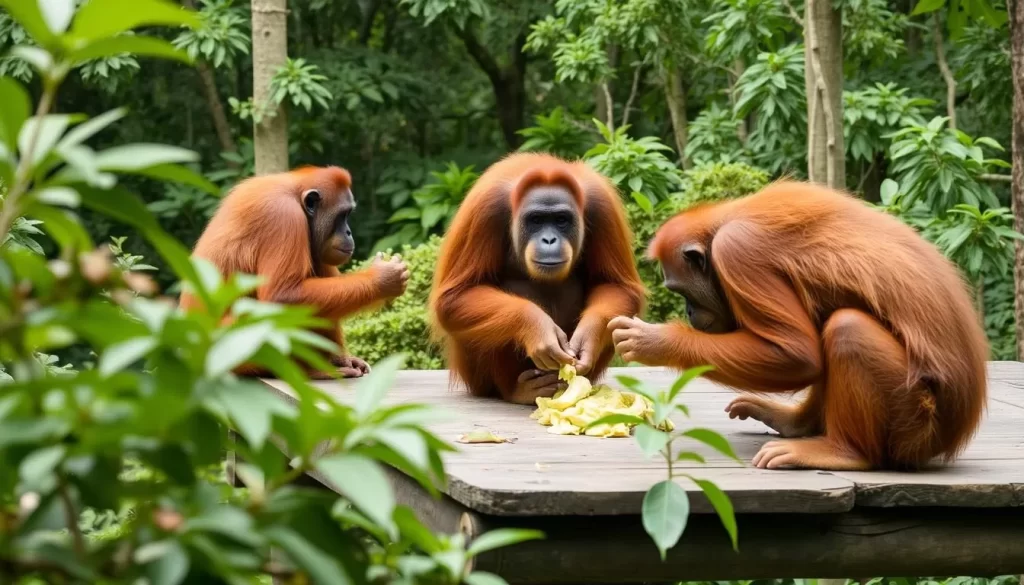
The Sepilok Orangutan Rehabilitation Centre is a world-renowned sanctuary dedicated to the care and rehabilitation of orphaned and injured orangutans. Located within a reserve, the centre provides a safe haven for these incredible creatures to receive medical treatment and care before being released back into the wild.
What to Expect at the Rehabilitation Centre
Your visit to the Sepilok Orangutan Rehabilitation Centre begins with a video introduction that shares fascinating facts about orangutans and the centre’s conservation efforts. Exhibits are also available to explore before the centre opens. The highlight of your visit is likely to be the feeding platform, where you can observe orangutans enjoying a diet that mimics their natural food sources, including fruits like bananas, papayas, and jackfruits, as well as sugar cane.
The feeding sessions are carefully managed to prevent the orangutans from becoming dependent on humans for food. Instead, they are encouraged to forage in the surrounding forest, gradually becoming more self-sufficient.
Best Times to Visit for Orangutan Feeding
To maximize your chances of seeing the orangutans, plan your visit around the feeding times, currently at 10 am and 3 pm. While morning sessions tend to be busier due to tour groups, afternoon visits might offer a more relaxed experience. It’s advisable to arrive at least 20 minutes before the feeding sessions to secure a good viewing spot.
Conservation Efforts and How You Can Help
The Sepilok Orangutan Rehabilitation Centre is not just a tourist attraction; it’s a vital conservation effort. The rehabilitation process can take up to 10 years and costs approximately 8,000 Ringgit per orangutan annually. By visiting the centre, you’re supporting the conservation work. You can also contribute by spreading awareness about the importance of orangutan conservation and the centre’s efforts.
Practical Information and Tips
The centre is open from 9 am to 12 pm and 2 pm to 4 pm, with the ticketing counter operating from 9 am to 11 am and 2 pm to 3:30 pm. Entry tickets are RM30 for foreigners, with an additional RM10 camera fee. Planning your visit according to the feeding times and being mindful of the centre’s rules will enhance your experience.
Bornean Sun Bear Conservation Centre

For those interested in wildlife conservation, the Bornean Sun Bear Conservation Centre is a must-visit destination in Sandakan. Located adjacent to the Sepilok Orangutan Rehabilitation Centre, this conservation centre is globally the only one focused on sun bears. Native to South-East Asia, the Malaysian Sun Bear is the smallest among the bear family and is classified as a vulnerable species.
Meeting the World’s Smallest Bears
The Sun Bear Conservation Centre is dedicated to rescuing, treating, and equipping sun bears with the necessary surviving skills before releasing them into the reserve. When you visit, you’ll find a large forest enclosure that is safe for the sun bears, with elevated walkways and platforms from which you can view the sun bears below. You can observe the sun bears climbing up and down trees, digging termites for food, or just lazing around, all in their most natural demeanor.
Unique Characteristics of Sun Bears: Sun bears have distinctive chest markings and play a significant role in the Bornean ecosystem. Their presence is an indicator of the forest’s health.
Conservation Challenges and Success Stories
Sun bears face numerous conservation challenges, including habitat loss, illegal hunting, and the pet trade. The Bornean Sun Bear Conservation Centre works tirelessly to address these issues through its rescue and rehabilitation efforts. The centre has had several success stories where sun bears have been successfully rehabilitated and released back into the wild.
The Importance of Conservation Efforts: By supporting conservation efforts, visitors can contribute to the protection of sun bears and their habitats. The “Adopt a Sun Bear” program is one such initiative that allows individuals to support the conservation of these amazing creatures.
Visitor Information and Photography Tips
The Bornean Sun Bear Conservation Centre is open daily from 9 am to 3:30 pm. The entry cost is RM50 for foreign adults and RM25 for children aged 2-17 years. For Malaysians, the entry fee is RM10 for adults and RM5 for children. To make the most of your visit, consider combining it with a trip to the Sepilok Orangutan Centre.
Photography Tips: To capture the best moments, be patient and keep your camera ready. The elevated walkways provide excellent vantage points for photography.
Rainforest Discovery Centre
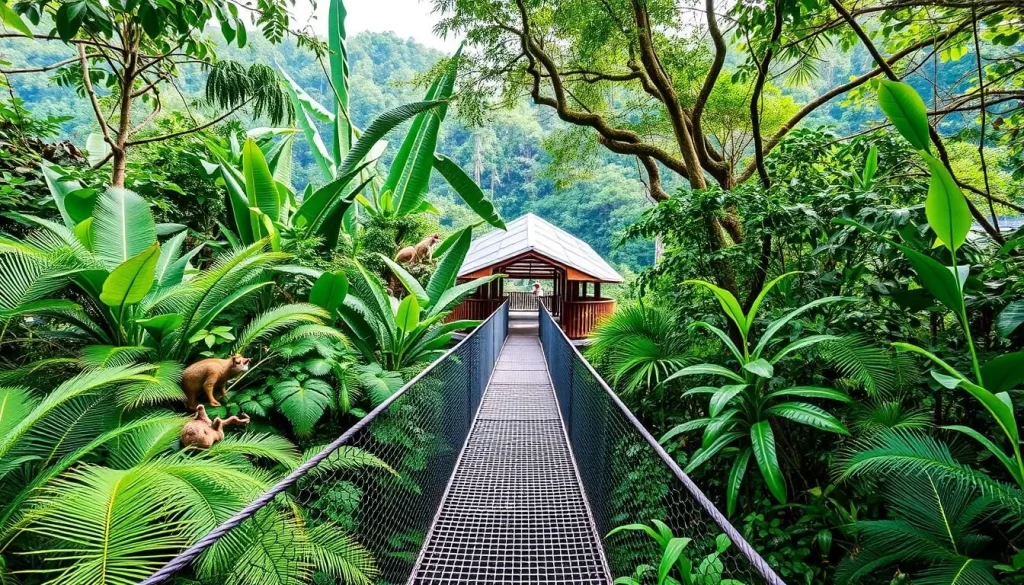
Nestled within the lush Kabili-Sepilok Forest Reserve, the Rainforest Discovery Centre is a must-visit destination for nature enthusiasts. Located just 2km from the Sepilok Orang-utan Rehabilitation Centre, this environmental education facility is run by the Sabah Forestry Department.
The Rainforest Discovery Centre offers a unique experience, with a 347-meter long Canopy Walkway that provides a bird’s-eye view of the surrounding forest. This walkway is not only an adrenaline rush but also a great opportunity to spot some of the 300 species of birds that call the centre home.
Exploring the Canopy Walkway
The canopy walkway is an unforgettable experience, taking you high above the forest floor. As you walk along the 25-meter tall structure, you’ll be treated to breathtaking panoramic views of the rainforest.
The walkway is also equipped with signboards to help non-bird experts identify some of the bird species. With its unique vantage point, you’ll have a chance to spot birds and other wildlife that are not easily seen from the forest floor.
Bird Watching Opportunities
The Rainforest Discovery Centre is renowned for its birdwatching opportunities. With over 300 species of birds documented, it’s a paradise for bird enthusiasts. The centre is also the official location for the Annual Borneo Bird Festival, held in October.
As you explore the centre, keep an eye out for the various lookout points along the canopy walkway, which are perfect for spotting rare bird species.
Night Walks and Special Programs
For a unique experience, join the Night Walk program, available on Monday, Wednesday, and Friday from 6pm to 8pm. This guided tour will give you the opportunity to spot nocturnal wildlife that is not easily seen during the day.
The centre also offers an Exhibition Hall and a Plant Discovery Garden, featuring over 250 species of native orchids, pitcher plants, and other exotic flora. Be sure to allocate at least a couple of hours to fully appreciate all that the centre has to offer.
Practical information: The Rainforest Discovery Centre is open daily from 8am to 5pm, with night walks available on specific days. Entry prices are RM20 for foreign adults and RM10 for children. Be sure to plan your visit accordingly.
Kinabatangan River Wildlife Cruises
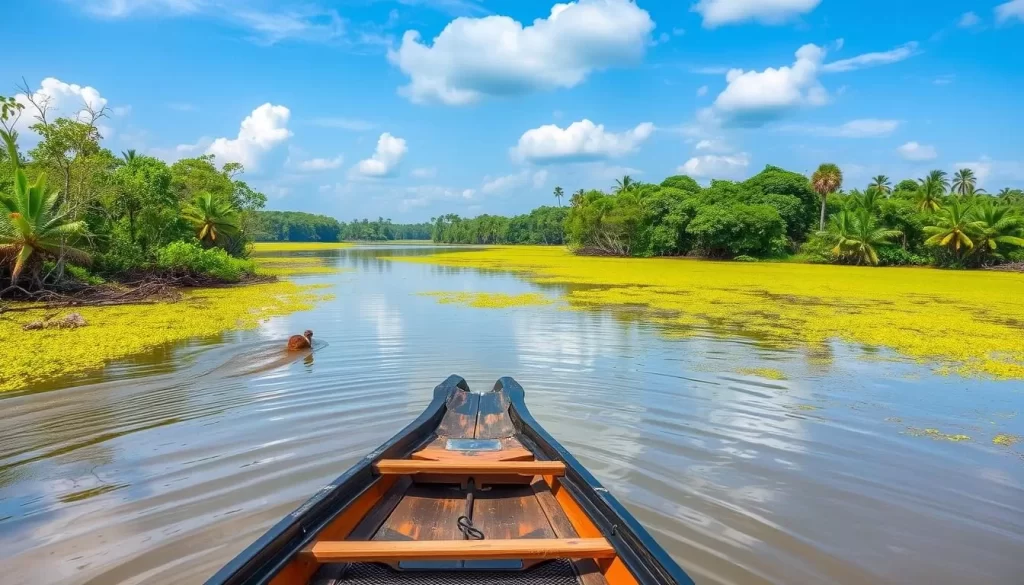
The Kinabatangan River, stretching 560 kilometers, is not only Malaysia’s second-longest river but also a thriving mangrove swamp that supports an incredible array of wildlife. This river is a haven for nature lovers and wildlife enthusiasts, offering a unique opportunity to observe diverse species in their natural habitat.
Wildlife You Can Spot on the River
The Kinabatangan River is renowned for its rich biodiversity. As you cruise along the calm river, keep an eye out for crocodiles, pygmy elephants, and various primate species, including orangutans, proboscis monkeys, macaques, and gibbons. The river is also a birdwatcher’s paradise, with exotic birds like kingfishers, hornbills, storks, and hawk-eagles.
The variety of wildlife is staggering, making the Kinabatangan River one of Borneo’s premier wildlife viewing destinations. With a bit of luck and the right guidance, you can spot some of the region’s most iconic and endangered species.
Morning vs. Evening Cruises: What to Choose
Both morning and evening cruises offer unique experiences. Morning cruises provide clear visibility and the chance to see active wildlife, while evening cruises offer dramatic lighting and the opportunity to observe different animal behaviors as the day cools down.
Choosing between morning and evening cruises depends on your preferences. If you enjoy the tranquility of the morning and spotting wildlife during their most active hours, a morning cruise might be the best choice. If you prefer the golden light of the setting sun and observing nocturnal behaviors, an evening cruise could be more appealing.
Overnight Stays and Jungle Lodges
To fully experience the Kinabatangan River, consider staying overnight at one of the jungle lodges along the river. These lodges offer the chance to participate in multiple wildlife cruises, explore the surrounding rainforest, and immerse yourself in the natural environment.
Staying overnight allows you to witness the river’s different facets, from the serene morning mist to the vibrant life during the night. It’s an opportunity to connect deeply with nature and enjoy the tranquility of the rainforest.
Photography Tips for River Wildlife
Capturing the wildlife along the Kinabatangan River requires the right equipment and techniques. Bringing a pair of binoculars and a telephoto lens can significantly enhance your photography experience, allowing you to get up-close shots without disturbing the animals.
Be patient and prepared for the changing light conditions, especially during early morning and late evening cruises. Understanding your equipment and being ready for the unexpected will help you capture the incredible moments on the Kinabatangan River.
Gomantong Caves: A Natural Wonder
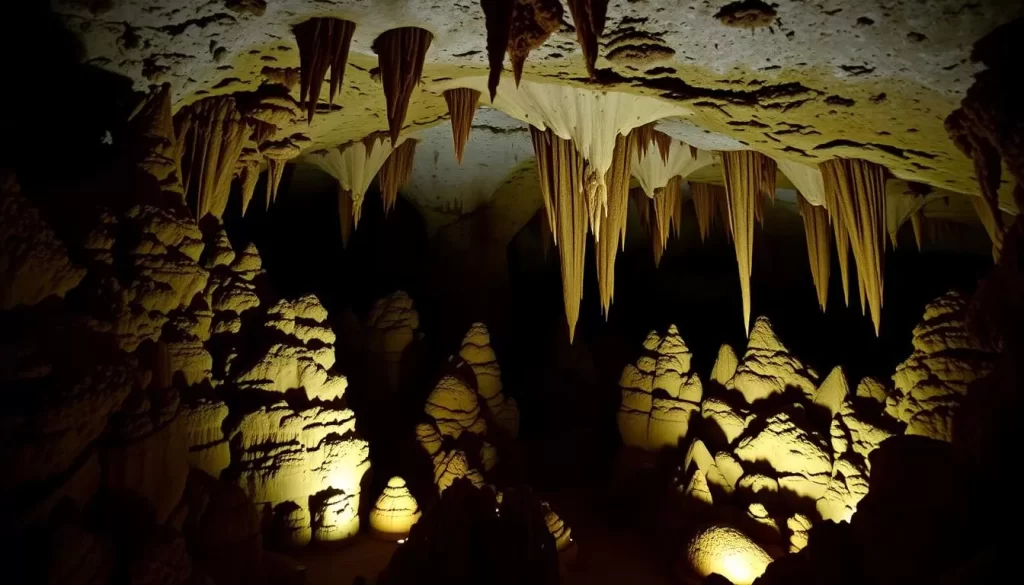
If you’re looking for an unforgettable experience in Sandakan, the Gomantong Caves are a natural wonder that shouldn’t be missed. This extensive limestone cave system is renowned for housing approximately 2 million bats and a myriad of other creatures such as cockroaches, centipedes, and cave crabs.
Exploring the Limestone Cave System
The Gomantong Caves offer a unique opportunity to explore its vast chambers. As you walk through the one-way boardwalk loop, you’ll be surrounded by the cave’s unique ecosystem. The caves are part of a larger ecosystem that includes the nearby Kinabatangan River, known for its rich biodiversity, including proboscis monkeys.
The cave’s interior is a fascinating world, with its own set of flora and fauna adapted to the dark, humid environment. The sound of the bats and the smell of guano are experiences you won’t soon forget.
The Bat Exodus and Bird Nest Harvesting
One of the most spectacular sights at Gomantong Caves is the bat exodus that occurs around sunset on a non-rainy day. Witnessing millions of bats flying out of the cave in search of food is a dramatic and unforgettable experience. Additionally, the caves are famous for their edible bird’s nests, which are harvested by locals using traditional methods.
The practice of bird nest harvesting is not only an important part of the local culture but also an economic activity. The nests are highly valued for their supposed health benefits, particularly in the famous bird’s nest soup.
Preparing for Your Visit
Before you visit the Gomantong Caves, it’s essential to be prepared. Wear sturdy shoes and be prepared for the strong smell of guano. Bringing a flashlight and insect repellent is also recommended. Visiting the caves as part of a guided tour, possibly combined with a Kinabatangan River cruise, can enhance your experience and provide insights into the local wildlife, including proboscis monkeys.
Timing your visit to coincide with the bat exodus can be a highlight of your trip. The caves are about a two-hour drive from Sandakan, making them an ideal day-trip destination.
Turtle Islands Park
Turtle Islands Park, comprising three islands off Sandakan’s coast, is a critical nesting site for green and hawksbill turtles. This protected marine sanctuary is not only a significant conservation area but also a unique destination for travelers.

Conservation Efforts and Wildlife Experience
The Turtle Islands Park has been a cornerstone of sea turtle conservation since 1984, protecting these magnificent creatures from extinction. Visitors have the once-in-a-lifetime opportunity to witness sea turtles laying eggs and baby turtles being released into the ocean.
The conservation efforts here are multifaceted, involving the protection of nesting sites, monitoring of turtle populations, and education of visitors about the importance of conservation.
Key Conservation Highlights:
- Protection of nesting sites for green and hawksbill turtles
- Ongoing research and monitoring programs
- Visitor education and community engagement
Overnight Stay Experience on Selingan Island
Selingan Island is the only island within Turtle Islands Park open to visitors, offering a unique overnight stay experience. The island’s accommodation options are designed to be comfortable while minimizing environmental impact.
Visitors can enjoy meals prepared by the island’s staff, with a focus on local cuisine. The overnight stay allows for a deeper connection with nature and the opportunity to witness turtle nesting activities under the guidance of park rangers.
The experience is not just about observing turtles but also about understanding the delicate ecosystem of the island.
Practical Information for Visitors
To visit Turtle Islands Park, it is essential to book in advance, especially during peak season, as only 38 visitors are allowed per night. The journey from Sandakan takes approximately one hour by boat.
Visitors must bring their passport for immigration requirements and pack accordingly for the island environment. The park provides educational opportunities at the turtle hatchery and information center, enhancing the visitor experience.
Visitor Guidelines:
- Book accommodations at least 3-6 months in advance
- Bring necessary documents like your passport
- Follow park rules for turtle viewing, including no flash photography
Sandakan Memorial Park
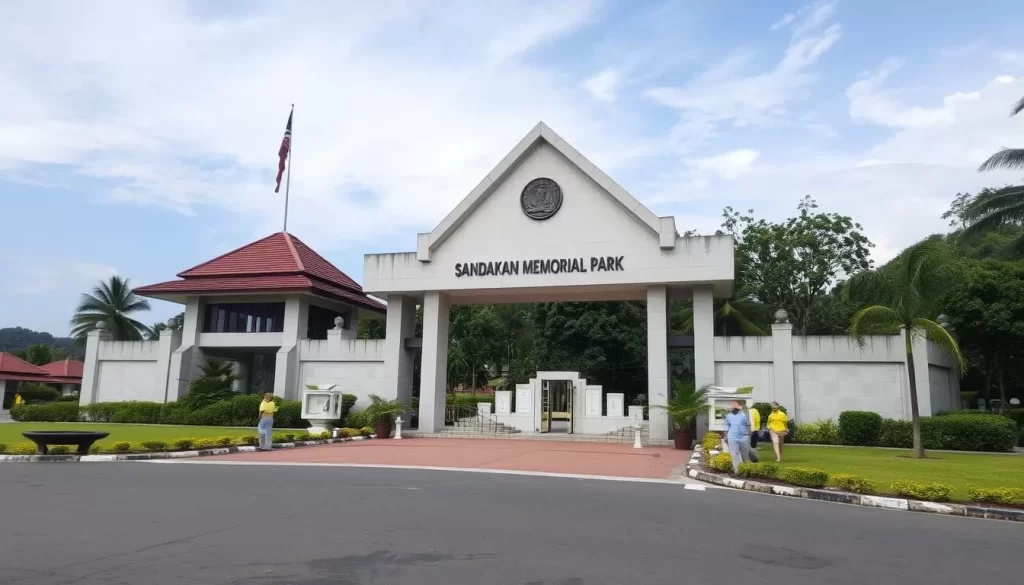
As you visit the Sandakan Memorial Park, 11km from Sandakan city, you are stepping into a site of great historical importance and somber reflection. The park is situated on the grounds of a former World War II prison camp, where thousands of prisoners of war suffered and lost their lives.
The Tragic History of the Death Marches
The Sandakan Memorial Park is a poignant reminder of the tragic events that unfolded during World War II. Approximately 2,500 Australian and British prisoners of war were held captive at the Sandakan POW camp, with many losing their lives due to the harsh conditions and brutal treatment.
Initially captured during the Battle of Singapore in February 1942, these prisoners were transported to Borneo to work as forced labor on the construction of a Japanese military airstrip. The conditions were grueling, and many prisoners succumbed to disease, malnutrition, and exhaustion.
In 1945, the surviving Australian prisoners were forced to carry baggage and supplies for the Japanese battalions relocating to the western coast of North Borneo. This arduous journey, known as the Sandakan Death Marches, took a devastating toll on the prisoners, with only six surviving out of thousands.
Exploring the Memorial and Museum
The Sandakan Memorial Park is not just a historical site; it’s also a place of remembrance and reflection. The park’s careful landscaping and modern signboards provide a serene atmosphere, while the few remaining artifacts, such as rusty machinery, serve as a reminder of the past.
The on-site museum houses exhibits, photographs, and personal accounts from survivors and witnesses, offering a deeper understanding of the events that took place. Visitors can explore the museum to gain a more profound appreciation of the sacrifices made by the prisoners of war.
Although there is no entry fee for the park or museum, donations are welcome and used for daily maintenance and upgrades. The Office of Australian War Graves operates an account for donations, which can be made payable to DVA Official OAWG Contributions.
The Sandakan Memorial Park holds significant importance, particularly for Australian and British visitors who have a personal connection to the history of the site. Annual memorial services are held here, especially on ANZAC Day, to honor those who perished.
Agnes Keith House and English Tea House
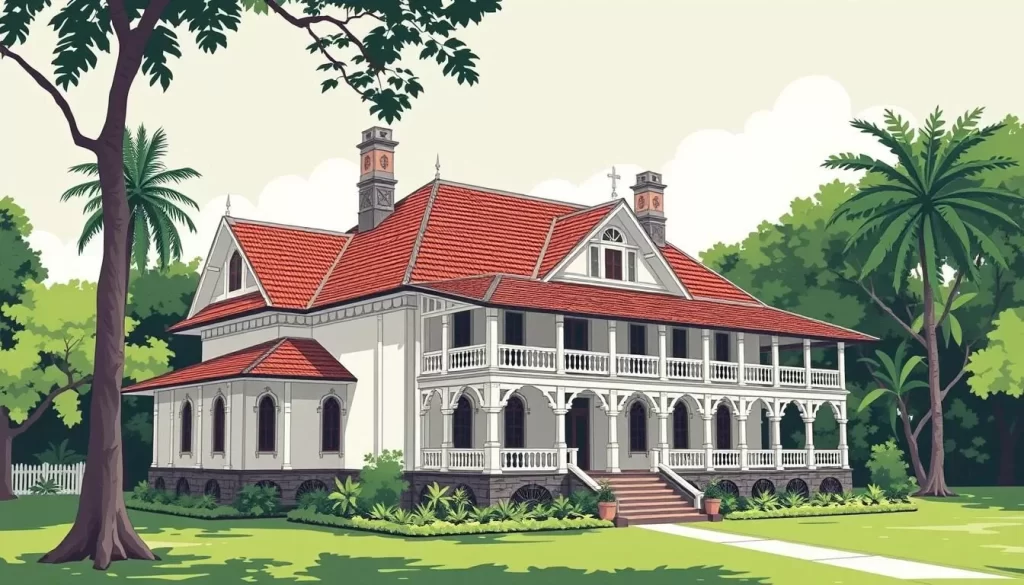
Step into the colonial past of Sandakan at the Agnes Keith House, a beautifully restored heritage site. This historic house, once the residence of Henry George Keith, his wife Agnes, and their son, is now a museum showcasing the life and times of the Keith family during the colonial era.
The Colonial History of Agnes Keith
Agnes Newton Keith, an American author, is renowned for her three books about her life in North Borneo before, during, and after World War II. Her most famous work, Land Below the Wind (1939), introduced many Western readers to life in Borneo. Another significant memoir, Three Came Home (1946), recounts the Keith family’s experiences as prisoners of war. Understanding Agnes Keith’s life and writings provides valuable insights into the region’s history and cultural heritage.
Agnes Keith’s story is not just about her personal experiences but also about the broader historical context of Sandakan during the colonial period and World War II. Her writings have contributed significantly to the historical record of the region, making the Agnes Keith House a significant cultural and historical landmark.
Touring the Restored House
The Agnes Keith House, originally known as ‘Newlands,’ was rebuilt after being destroyed during World War II. It became the first government permanent timber building constructed post-war. Today, the house is furnished with reproductions of colonial furniture and antiques, offering visitors a glimpse into the life of the Keith family and the colonial era in Sandakan.
As you tour the house, you can explore the various rooms and admire the period furniture and memorabilia on display. The heritage museum provides a comprehensive look at the history of the Keith family and their significance in Sandakan’s history.
Dining at the English Tea House and Restaurant
Adjacent to the Agnes Keith House is the English Tea House & Restaurant, a colonial-styled eatery that offers a delightful dining experience. Situated in a lush garden overlooking Sandakan Bay, the restaurant provides breathtaking views and a serene ambiance.
Enjoy traditional English cuisine, afternoon tea, and refreshing cocktails in the beautifully landscaped garden setting. The English Tea House is an ideal spot to relax and unwind, complementing your visit to the Agnes Keith House with a taste of colonial-era elegance.
Sandakan, Malaysia: Best Things to Do for History Buffs
For those fascinated by history, Sandakan, Malaysia, is a treasure trove of significant landmarks and cultural heritage sites. The city’s rich past is reflected in its numerous historical attractions, which provide a glimpse into its cultural and historical significance.
St. Michael’s and All Angels Church
One of Sandakan’s most notable historical landmarks is St. Michael’s and All Angels Church, the oldest stone building in Sabah. This church took 13 years to complete and was opened in 1903. During World War II, it was bombed and burned, but a major restoration was completed in the 1950s. The church’s history is deeply intertwined with the wartime events, having been used by the Japanese army for military purposes and as a transient stay for POWs. Today, the church is adorned with magnificent stained-glass windows, installed as a memorial to POWs and a gesture of appreciation to the local community for their support during the war.

Visitors can explore the church and discover its wartime history, including its use by the Japanese army and its subsequent restoration. The beautiful stained-glass windows are a highlight, serving as a poignant reminder of the past.
Sandakan Heritage Museum
The Sandakan Heritage Museum is another significant historical site in the city, offering insights into Sandakan’s diverse cultural heritage. The museum features exhibits on American adventurers Martin and Osa Johnson, who documented Borneo in the 1920s and 1930s. Their film documentaries have left a lasting legacy, providing a unique glimpse into the region’s past. The museum is included in the free walking tours offered on Wednesdays and Fridays by Borneo Sandakan Tour, making it easily accessible to visitors.
| Attraction | Historical Significance | Visitor Information |
|---|---|---|
| St. Michael’s and All Angels Church | Oldest stone building in Sabah, significant wartime history | Open to visitors, guided tours available |
| Sandakan Heritage Museum | Exhibits on local cultural heritage and historical figures | Included in free walking tours on Wednesdays and Fridays |
| Puu Jih Shih Buddhist Temple | Grand architecture, panoramic views of Sandakan Bay | Open to the public, photography allowed |
Puu Jih Shih Buddhist Temple
Perched on a hilltop overlooking Sandakan Bay, the Puu Jih Shih Buddhist Temple is a relatively modern structure built in 1987. Despite its modern construction, the temple boasts intricate carvings and statues comparable to ancient temples in the region. Visitors are free to roam the temple grounds, take photographs, and enjoy the lush gardens and panoramic views of the bay. The temple’s grand architecture and colorful lanterns make it a perfect spot for capturing memorable photos.
As you explore these historical sites, you’ll gain a deeper understanding of Sandakan’s rich history and cultural heritage. Whether you’re visiting St. Michael’s and All Angels Church, the Sandakan Heritage Museum, or the Puu Jih Shih Buddhist Temple, each location offers a unique perspective on the city’s past and its significance.
Local Markets and Food Experiences
The flavors of Sandakan are as diverse as its culture, with a range of local markets and eateries to discover. As you explore this vibrant city, you’ll find that its culinary scene is deeply rooted in its history and the surrounding natural environment.
Sandakan Central Market
For a more intriguing shopping experience, head to Sandakan Central Market, where locals shop for fresh produce, seafood, and exotic fruits you may never have seen before. The market is a bustling hub of activity, with vendors calling out their daily specials and shoppers haggling for the best prices.
- Explore the vibrant stalls, discovering unique local ingredients that form the foundation of Sandakan’s diverse culinary scene.
- Sample some of the fresh produce and local delicacies available, getting a taste of the authentic flavors of Sabah.
- Learn about the different types of seafood on offer, from fish to crustaceans, and how they’re typically prepared in local cuisine.
Located right next to other city attractions, the Sandakan Central Market is an ideal place to visit during your stay, offering a glimpse into the daily lives of the locals.
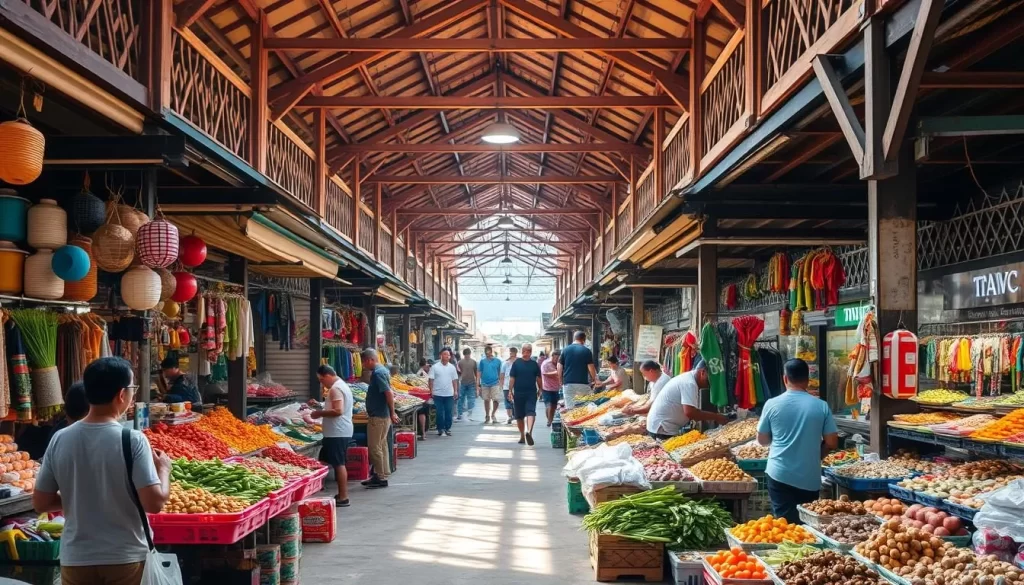
Must-Try Local Dishes in Sandakan
Sandakan’s culinary heritage is a reflection of its multicultural influences, including Chinese, Malay, and indigenous communities. Be sure to try some of the local specialties during your visit.
- Me Sup Sandakan (Sandakan noodle soup), a hearty and flavorful dish that’s a staple in local cuisine.
- UFO tarts (flying saucer-shaped pastries), a unique dessert that’s both delicious and visually appealing.
- Fresh seafood prepared in various styles, showcasing the city’s coastal location and the freshness of its seafood.
For a truly authentic dining experience, consider visiting a local restaurant, such as the house restaurant at the English Tea House, which serves traditional Malaysian dishes in a charming setting.
Food Tours and Cooking Classes
To further enhance your culinary experience in Sandakan, consider joining a food tour or cooking class. These guided experiences can take you to hidden gems and local favorites that you might not discover on your own.
- Learn about the best eating spots in the city, from street food stalls to local restaurants, and sample a variety of dishes.
- Participate in a cooking class where you can learn to prepare authentic Sabahan dishes using ingredients purchased right next at the central market.
- Some tours may even include a visit to the Kinabatangan River, where you can enjoy a meal or snack in a picturesque setting surrounded by wildlife.
Day Trips from Sandakan
Uncover the best of Sabah’s natural and cultural heritage through the various day trips available from Sandakan. With its strategic location, Sandakan is an ideal base for exploring the region’s wildlife sanctuaries, historical sites, and natural wonders.
Selingan Island (Turtle Island) Day Trip
A day trip to Selingan Island, also known as Turtle Island, offers a unique opportunity to witness sea turtle conservation efforts. Although overnight stays are recommended for the best chance to see turtles laying eggs, a day trip can still provide a meaningful experience.
Sepilok and Wildlife Sanctuary Combo Tours
For those interested in wildlife, combination tours that include visits to the Sepilok Orangutan Rehabilitation Centre, Bornean Sun Bear Conservation Centre, and the Rainforest Discovery Centre are available. These tours allow you to experience the diverse wildlife of Sabah in a single day.
Sandakan City Half-Day Tours
If you’re looking to explore Sandakan town itself, consider joining a half-day tour. These tours typically cover historical and cultural sites such as the Sandakan Memorial Park, Puu Jih Shih Buddhist Temple, and St. Michael’s Church, providing insights into the city’s history and cultural diversity.
These day trips from Sandakan offer a range of experiences that cater to different interests, from wildlife and nature to history and culture. Whether you’re looking for adventure or insight into the local way of life, there’s a tour available to suit your needs.
Where to Stay in Sandakan
From luxury resorts to budget-friendly guesthouses, Sandakan has an array of options for travelers to choose from. Whether you’re looking to be close to nature or in the heart of the city, there’s something for everyone.
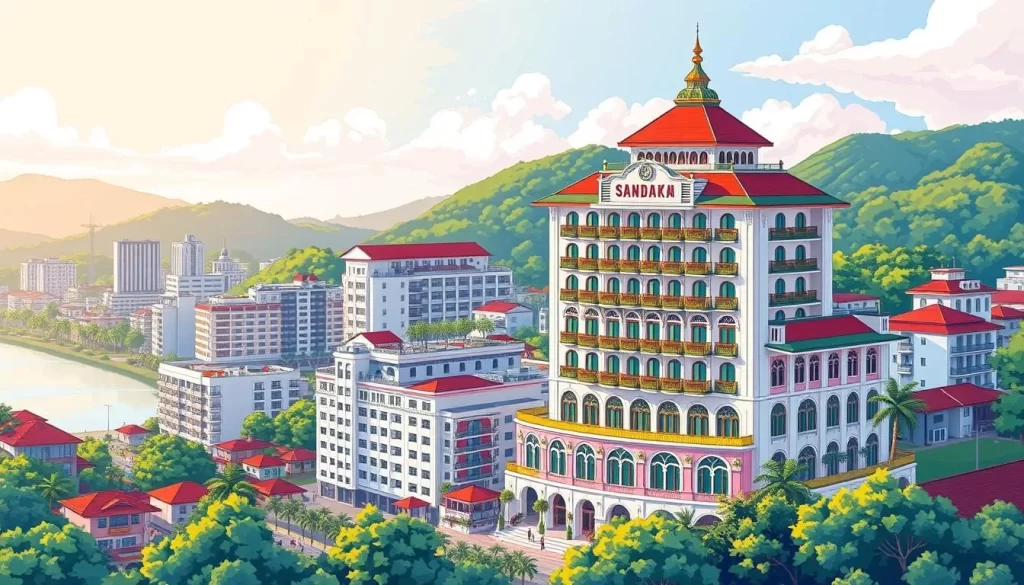
Luxury Accommodations
For those seeking a luxurious experience, Sandakan offers several high-end resorts. Sepilok Nature Resort is a standout, located just a 5-minute walk from the Sepilok Orangutan Rehabilitation Centre and the Bornean Sun Bear Conservation Centre. The resort’s spacious wooden chalets are set amidst a beautiful lake and tropical gardens, offering a serene and natural ambiance.
The chalets are equipped with plush beds, in-room seating areas, and flat-screen TVs. Guests can also enjoy the private verandas with hanging plants and hammock chairs, perfect for relaxing. The resort’s in-house restaurant serves fine dining, and there’s a full bar for those looking to unwind.
Mid-Range Hotels and Resorts
For travelers looking for a balance between quality and affordability, Sandakan’s mid-range hotels are a great choice. S’Kan Styles Hotel at Sandakan Harbour Square is a popular option, offering comfortable waterfront rooms with modern amenities. The hotel is located right next to the ‘I Love Sandakan’ sign, making it a great spot for photos.
The rooms come with luxurious rain showers, free internet, and a coffee and tea set. Guests can enjoy breakfast at the onsite Treats Restaurant. While the standard rooms are a bit compact, they’re perfect for single travelers or couples. The hotel also offers Family Rooms and Suites for those needing more space.
Budget-Friendly Options
Travelers on a tight budget will find several affordable options in Sandakan. While specific budget-friendly hotels weren’t detailed, it’s clear that Sandakan caters to all budgets. When looking for budget accommodations, consider staying in the city center for easy access to restaurants and services, or near wildlife attractions like Sepilok for early morning access.
For those interested in exploring beyond Sandakan, jungle lodges along the Kinabatangan River offer immersive wildlife experiences, including river cruises. Some lodges also offer family-friendly rooms and connecting suites, making them ideal for travelers with children.
It’s advisable to book your accommodations in advance, especially during peak tourist seasons, to ensure availability.
Getting Around Sandakan
To make the most of your trip to Sandakan, understanding the local transportation is key. Sandakan is a city with a plethora of attractions spread out across the landscape, from the Sepilok Orangutan Rehabilitation Centre to the Kinabatangan River. While it might seem daunting, navigating these locations is relatively straightforward once you’re aware of your options.
Transportation Options
Sandakan offers various transportation options to suit different needs and preferences. For flexibility and convenience, local taxis and ride-sharing services are available, making it easy to navigate between the city and outlying wildlife centers.
The public bus system is another option, connecting Sandakan city with Sepilok and other nearby destinations. However, be aware that the schedules are limited, so planning ahead is advisable.
If you prefer independence, renting a car is a viable option. Though, it’s worth noting that some rural roads can be challenging, especially for inexperienced drivers.
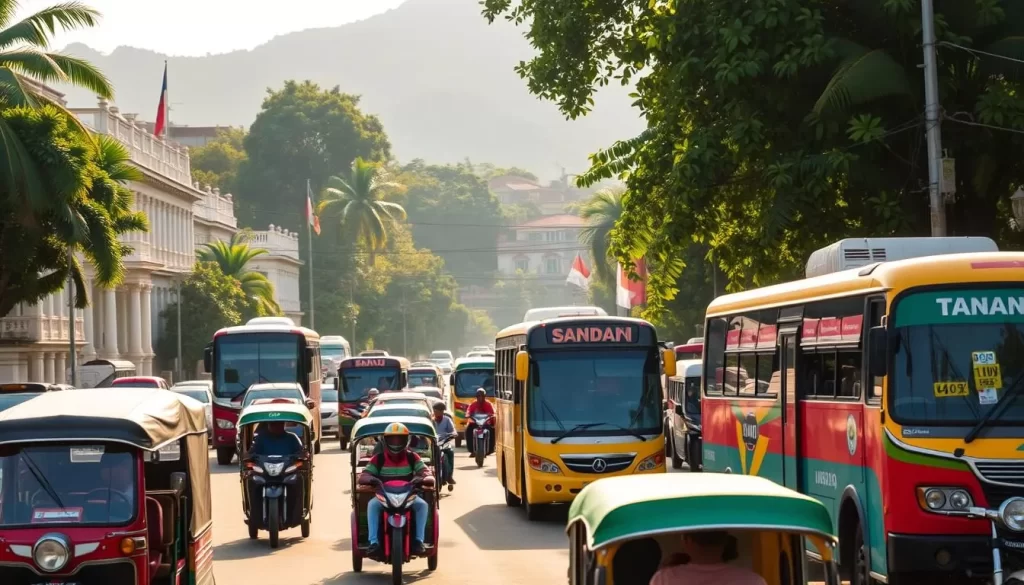
- Local taxis and ride-sharing services for flexibility.
- A public bus system connecting major attractions, albeit with limited schedules.
- Car rental services for those who prefer todrive themselves, with the caveat of potentially challenging rural roads.
Understanding these options can help you plan your itinerary more effectively, ensuring you make the most of your time in Sandakan.
Hiring Guides and Drivers
For a more personalized experience, consider hiring private drivers for full or half-day excursions. This option is not only cost-effective for groups but also provides the benefit of local knowledge, enhancing your overall experience.
Guided tours that include transportation to multiple attractions are another convenient option. They save you the hassle of arranging separate transport, allowing you to focus on enjoying your experiences.
For instance, if you’re planning to visit the Rainforest Discovery Centre for a night walk, staying in Sepilok can minimize travel time and maximize your experience.
By understanding your transportation options and considering the hiring of guides or drivers, you can navigate Sandakan with ease, ensuring a memorable and stress-free trip.
Conclusion: Planning Your Perfect Sandakan Itinerary
Sandakan, a hidden gem in Malaysian Borneo, offers an unforgettable experience for travelers. With its rich history, diverse wildlife, and cultural attractions, you can create a personalized itinerary that suits your interests and schedule.
To make the most of your visit, consider a minimum stay of 3-4 days. This allows you to explore the Sepilok Orangutan Rehabilitation Centre, visit the Bornean Sun Bear Conservation Centre, and take a Kinabatangan River cruise without feeling rushed. Planning your visit around feeding times at wildlife centers can maximize your chances of animal sightings, such as the orangutan feedings at 10 am and 3 pm.
Combining nearby attractions, like the orangutan and sun bear centers, on the same day can be efficient. An overnight stay along the Kinabatangan River can provide a unique experience, allowing you to enjoy both morning and evening wildlife cruises. Balancing your itinerary with a mix of nature, historical sites, and cultural experiences, such as visiting the Agnes Keith House and English Tea House, will enrich your understanding of Sandakan.
It’s also essential to plan for weather contingencies, especially during the rainy season from November to February, when outdoor activities might be affected. Creating sample itineraries for different trip durations can help you make the most of your time in Sandakan, whether you’re planning a packed 2-day visit or a leisurely week-long exploration.
By carefully planning your trip and considering these factors, you’ll leave Sandakan with a deeper appreciation for its unique blend of wildlife conservation, colonial history, and cultural diversity. Sandakan is truly one of Malaysian Borneo’s most rewarding destinations, offering an experience that will stay with you long after your trip is over.
The above is subject to change.
Check back often to TRAVEL.COM for the latest travel tips and deals.

